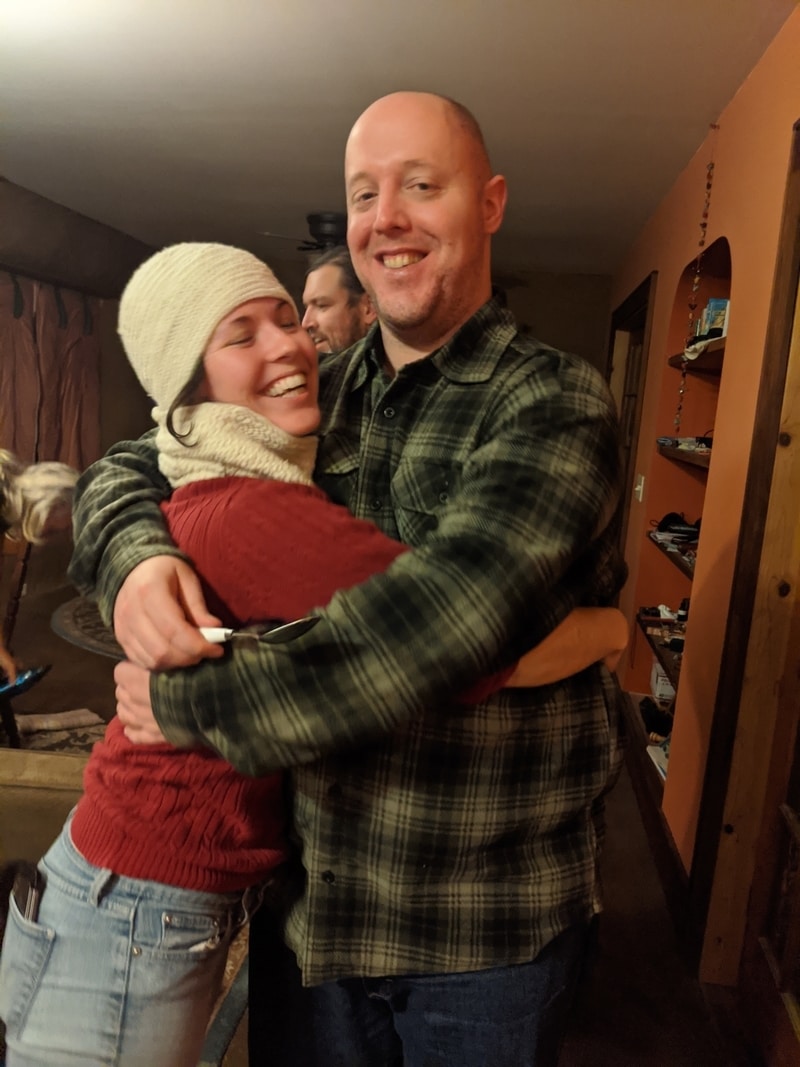CSCC Replaces Hierarchy Operating System with Holacracy
Published: Tue, 06/16/20

CSCC Replaces Hierarchy Operating System with Holacracy
Updates and Articles from Dancing Rabbit Ecovillage
 Carolyn and Vick, two employees of CSCC, celebrating working at our ecovillage based nonprofit
together.
Carolyn and Vick, two employees of CSCC, celebrating working at our ecovillage based nonprofit
together.In the month of May, the staff of the Center for Sustainable and Cooperative Culture at Dancing Rabbit Ecovillage decided we were bored of playing the game of “hierarchy” with each other and officially transitioned to playing Holacracy, instead. My name is Avi, and I’m here to share a little bit about this switchover with you.
Holacracy is an organizational operating system — the way an organization organizes itself and performs its work. Generally, there is a seen and unseen version of an organization’s operating system. There is the organizational chart, job descriptions, and policies of the organization; and then there are the unseen, and generally unspoken, social or “political” dynamics that shape the way a group of people work together.
Holacracy acknowledges the existence of the unseen organizational operating system and seeks to make it seen by encouraging the understood organizational structure to be continually and dynamically updated by new information. That is, it seeks to routinely update itself based on the constantly changing reality of how the work of an organization gets done without attachment to staying within the confines of the articulated, and often chiseled-in-stone, rigid organizational structure.
What is Holacracy?
Taken from “Holacracy” by Brian Robertson, the founder of the system:
“What is Holacracy? Essentially, it’s a new social technology for governing and operating an organization, defined by a set of core rules distinctly different from those of a conventionally governed organization. Holacracy includes the following elements:
- A constitution, which sets out the “rules of the game” and redistributes authority
- A new way to structure an organization and define people’s roles and spheres of authority within it
- A unique decision-making process for updating those roles and authorities
- A meeting process for keeping teams in sync and getting work done together”
Having an articulated constitution govern the way the organization functions reduces the power-playing dynamics that characterize human groups. I say reduce and not eliminate because there are still power-playing dynamics based on interpretations of said constitution as well as how it is used and broken by the individuals playing the game.
Ultimately, the way a human organization operates is a function of leadership within the group regardless of the system being used. That said, in Holacracy there’s more explicit opportunity for everyone in the organization to exercise leadership and authority, due to the constraints and rights provided by the constitution, than is often found in a traditional, hierarchical organizational structure, in which the people at the top of the hierarchy have the ability to micromanage and otherwise stifle the ability for subordinates to bring forth meaningful information and action.
From the other end of the spectrum, consensus decision-making operating systems tend to replace a concentration or centralization of power with a power vacuum in which there are little to no explicitly defined constraints on how individuals are to propose action that would involve an individual exercising personal authority. As a result, those more willing to be disagreeable and withhold consent often end up with greater power, and thus ability to affect what actions are or aren’t able to be taken by others in the group.
Holacracy seeks to constrain members of the organization from exercising control over another role’s domain while maintaining a high level of accountability, transparency, and collaboration within the group.
Why Holacracy for CSCC?
There’s a lot that could be said on a theoretical level about what CSCC is hoping to accomplish, and model, by making this transition from hierarchy to Holacracy. But as for the why, it really comes down to one thing: our Executive Director Danielle Williams felt that the staff could better process “tensions” — a Holacracy term that describes the gap between how things are and how things could be if improved — into meaningful, timely action if we moved from conventional hierarchy to Holacracy as a means of distributing authority.
Though not a magic bullet, our meetings have become more collaborative and the consensus among the staff is that we all have a better sense of what each other are working on at any given time. I know I have a better sense of what the entire organization is doing and how, which allows me to collaborate and perform my role in a more synergistic way. Previously, the bulk of communication and resource sharing and/or allocation flowed up the organizational chart to the Executive Director before being diverted back down to another department.
The language of Holacracy has also enabled us to hold one another accountable to being solution-oriented in the tensions we bring forward and identify, rather than comfortably disempowering ourselves and complaining up the chain-of-command in hopes of someone-else, somewhere-else with power coming to our rescue.
The transition is a work-in-progress and only recently have we reached the point where we have more or less begun to use the full functionality of the Holacracy system and its components — meeting processes, strategy and priority setting, organizational structuring, metric and recurring action reporting and review, etc.
Robertson likes to compare the Holacracy system to a ruleset that governs a group of people playing a sport together. The rules exist to give structure to the gameplay, remaining in the background of the game until a player attempts to make a move that breaks said rules, at which point someone else stops play and enforces a rule that marks a boundary of gameplay. When first undertaking a new sport, gameplay is often choppy and ungraceful with a lot of time spent on learning and re-learning the rules of the game. This has been our experience at CSCC as well, with stretches of satisfying, fluid play leading us to believe enduring the awkward beginning phases of the transition will pay substantial dividends down the road. The hope is that the time invested in learning a more complicated game, not unlike chess, will afford us greater organizational stimulation and development than sticking with a relatively simple, more limited game, such as checkers.
-Avi Maistri
CSCC Collaboration Engineer


